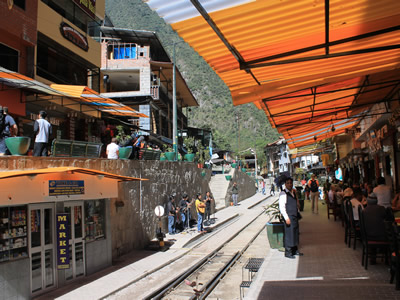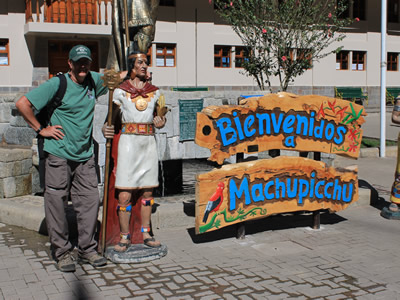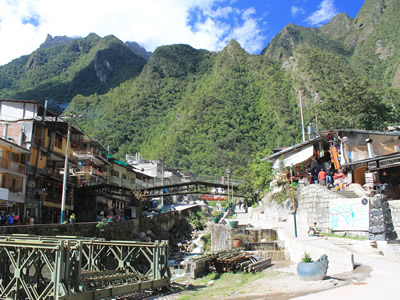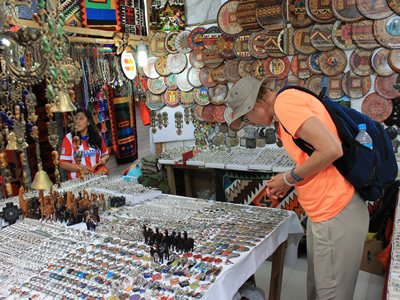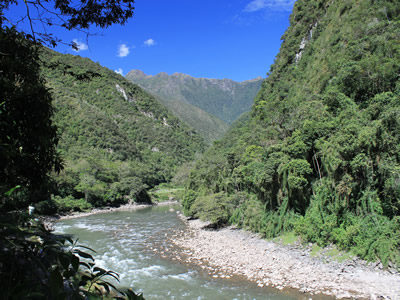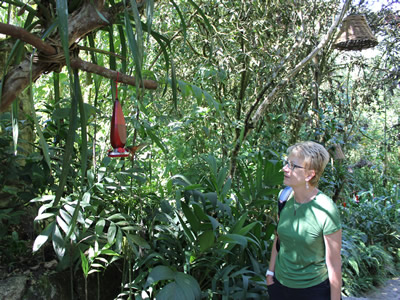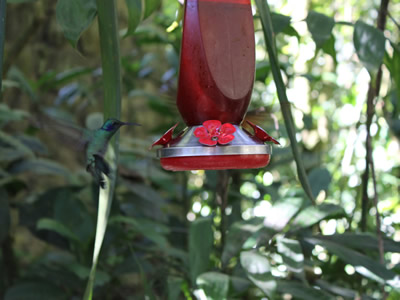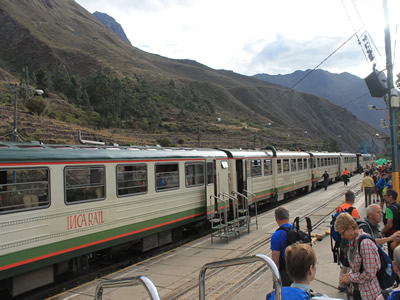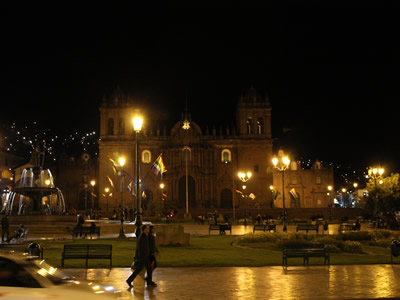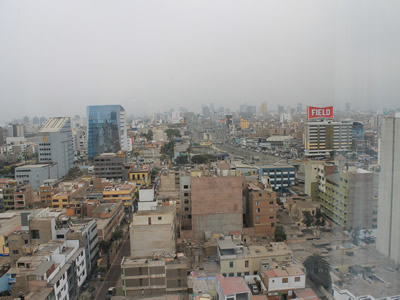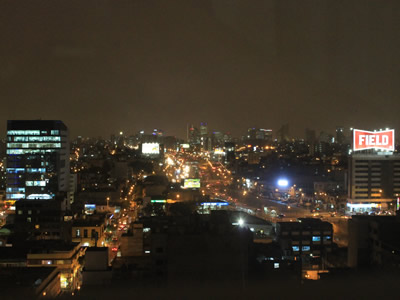Peru - Wrapping It Up
Our visit to Machu Picchu had been great. Although there were lots of people there, it was well worth braving the crowds to see it. It definitely is a bucket list item - one of those places that everyone should try to visit during their lifetime, like the Great Wall of China, Angkor Wat, or the Himalaya. Make sure that you put it on yours.
Pretty much the whole trip had been designed around the visit to Machu Picchu. Now that we had done it the trip was starting to wind down. We had some time left in Peru and there were still things that we to see and do, but I had to admit that they were a little anticlimactic. We also started to remember that we were far from home. It was time to wrap things up and start the long trip back.
We didn't opt to do more touring at Machu Picchu after our lunch there. We decided to catch a bus back to town. Even though it was early to be heading back, there already was a line for the bus that wrapped around the end of the road. But just as this morning, there was a bus coming every few minutes. As soon as a bus had loaded up and pulled out, there was another one waiting to take its place. They were moving a lot of people.
When we got down we still had most of the afternoon to explore Aguas Calientes. This is the town that serves as the base for visits to Machu Picchu. The steady stream of busses takes people who arrive on the train from Cusco, who camp nearby, or who stay in one of the many hotels. It was established in 1901 as a camp for people working on the construction of the railroad. Now the entire town is oriented around tourism. It even changed it's name officially to Machupicchu Puebla for marketing purposes, although everyone still calls it Aguas Calientes.
There is no highway to Aguas Calinetes - you can't drive there. The only way to reach it is by train or by walking. So the layout of the town is interesting. The "main street" of the town is actually along the train tracks. The only road leads from the bus station out of town and up to Machu Picchu. All of the other streets of the town are really pedestrian walkways. There are no cars or trucks. A lot of people don't like Aguas Calientes. They think it is haphazard and full of tacky tourist developments. But any town with no vehicle traffic that is just for walkers gets points in my book.
So we walked for an hour. It isn't very big so we covered the whole town. There are hotels, restaurants and souvenir shops. That's about it. And lots of people. Many of the restaurants had patio seating, and it was full. People were eating a late lunch or just sitting and enjoying a drink, watching the people pass by. At least two bars had live bands playing that you could hear all down the street, and one band was outside playing next to the train tracks. As Sandy would say, the place was hoppin'.
The other axis of the town was along the Rio Aguas Caliente. As the name implies, it has hot springs which gave the town its original name. Buildings lined the river so that the town was T-shaped. The stem of the T was short, along the river coming down from the hills. The cross of the T was long, following the tracks. Not far beyond the tracks the town ended abruptly at the Rio Vilcanata, the large river that filled the bottom of the valley. On both sides of the valley were steep cliff sides covered with vegetation. It was kind of like being in a fuzzy version of Yosemite Valley.
After walking around town we went to the market. The best shopping was really there. It was similar to the San Pedro Market in Cusco. In fact, we saw a lot of the same stuff, although slightly more expensive. It was still a good deal and we weren't going to have time in Cusco to go back to the market there. We especially wanted to take advantage of the inexpensive craft items to get gifts for family and friends. Sandy bought more scarves. They were very colorful and a good deal considering all the work that went into making them. Jewelry was also a good deal. Sandy got something for herself, and both her and I got some for gifts. While she was picking out jewelry I spent quite a bit of time at a CD stand right across the aisle. They were playing...wait for it... Peruvian pan flute music. In spite of what South Park says about Peruvian pan flutes, we liked the music. So I took my time trying several CD's until I found what I thought was a really good one. It was by a Peruvian band called Alborada. Since we have been back we have listened to it a lot and really like it. I've tried to find more of their CD's online but they are hard to come by. I guess I should have bought a couple more while we were there.
Ok, ok, I confess, I got a couple more tshirts. Hey, when am I going to be back in Peru? I got them while I had the chance. Good thing that I didn't repeat the mistake that we made with the CD.
When we finished our shopping we went back to the hotel to clean up and rest before we got together with the group for dinner. Although there were many hostels and low end hotels in town, the place that we stayed at, the Inkaterra, was fantastic. It was on the very edge of town. That means that it was two blocks from the train station. It is on twelve acres of land. It's in lush forest, like being in a park, complete with nature trails. One of the coolest things was a hummingbird feeder that we had to pass every time we went to or from our room. There were usually several hummingbirds there whenever we went by. These were bigger and much more colorful than the hummingbirds that we are used to in our back yard. Sometimes they would even land on tree branches, something the hummingbirds at home never do. And they were always fighting each other over the feeder. They seemed pretty tame. They didn't mind that people were walking by all the time just a few feet away from them.
Some of our group was pressed for time and left right from Machu Picchu. The Californians, Blair and Cari and Tim and Kelly caught the afternoon train from Aguas Calientes, then had flights to Lima, LA and then the Bay Area. That's a heck of a long day but they had kids and work to get back to. I'm glad that we didn't have such an aggressive schedule.
Jairo was gone too. He had left for his home in Cusco the day before when we reached Aguas Calientes.
Than night I was feeling good again and was hungry! We had a relaxed dinner with what was left of the group at our hotel. Our train the next day wasn't until the afternoon so we could sleep in. We met the group again for lunch at the SUMMAQ Hotel, the other really nice hotel in Aguas Calientes. It was outside of town about a quarter of a mile down the road to Machu Picchu, overlooking the river. I continued my wild and crazy experimenting with food, something I rarely do when I travel, by ordering the alpaca steak. The meat was very lean and quite tasty. I liked it. Then it was time to go to the train station.
The train ride the day before to Aguas Calientes was short but the train was very nice. Today we had a longer ride and fortunately the train was just as nice. The cars were new. The seats were comfortable. There was plenty of space. The windows were large and provided a great view. I enjoyed the trip. The trains even ran on schedule. Peru Rail was a good way to travel. And remember that I'm used to riding the trains in Switzerland.
Traveling from Aguas Calientes to Cusco was complicated. The train didn't go all the way but ended in Ollantaytambo, a town in the Sacred Valley. We found our bus, one of those medium size ones they use for rental car shuttles. Or that old age homes use to drive senior citizens around. I'm not sure which category we were in. There was plenty of space and it was really comfortable but it looked like we would be stuck for a long time. There was just a single road through town that ended at the train station. There were cars, vans and buses everywhere. It was a mess. Miraculously it unraveled itself quickly and in a few minutes we were on our way.
Above the town I could see a major Inca ruin. Originally a royal estate during the time of the Inca Empire, it was converted to a fort by the inca resistance during Manco Inca's revolt. Here the Incas fought and won their last battle in 1536 against the Spanish, although the rebellion ultimately failed. Two of our group, Derek and Tamara, had visited the town before the trek and said it was worthwhile.
We rode through the Sacred Valley and then drove up and over to the Cusco basin. As we went over the pass we had a beautiful view of the snow peaks of the Cordillera Urubamba in the evening light. It was a spectacular last view of the mountains for our trip. Then we crossed over and dropped down into the city of Cusco. We almost made it back to our hotel when we got stuck.
The one way street we were on was very narrow. We were near the Plaza de Armas so people had parked on both sides of the street. That barely left enough room for a car to squeeze in between them. The problem is we weren't in a car, we were in a medium size bus. It got tighter and tighter until we reached a place where we couldn't go forward anymore - there wasn't enough room. We couldn't back up because there were cars behind us. It looked like we were stuck forever. I recognized where we were. Next to us was a pedestrian walkway that went to our hotel in only a hundred meters. I was ready to abandon ship and walk. But Juan got out and started to direct the driver. I don't know how he did it, but somehow he talked the driver through the tight spot. I saw him do it and I still didn't believe it.
When we got to the hotel we collected our bags from storage and then went out to eat. It was late but we knew Cusco was a late-night city. We had a good dinner at an Italian restaurant on the Plaza de Armas. Afterwards we took one last walk around the square. Sandy wanted to take a final look at the nice alpaca sweaters. She decided to pass. Although they were gorgeous they were well over a hundred dollars. A good price but not as much of a bargain as we were getting on the simpler craft stuff. Then it was back to the hotel to get our storage bags and travel bags coalesced into our luggage for flying home.
Next day we had an early morning flight to Lima. We had a long layover there - like fifteen hours. Mountain Travel had someone pick us up and take us to a nice hotel to check into day rooms. It was extravagant but at least we didn't have to hang around the airport all that time. The hotel was in Miraflores, the most upscale district in Lima. Sandy and I went on a walking tour down to the ocean. There was a real mall there with western stores and a Tony Romas, where we had a late lunch. (Hey, I had experimented enough with local foods on this trip.) Then we walked along the coast for a while before heading back to our hotel. We both decided to lie down for a while to try to take naps. I'm not sure we slept but at least we had a rest before getting a ride back to the airport at 8 pm.
At least we got an idea of what Lima is like. It's a strange place. It's right on the coast, but there was a line of bluffs all along the water so it didn't feel like the city was on the ocean. And it was cloudy and gray. Our driver told us that it is foggy about eight months out of the year. There is almost no rain - only one or two inches a year for different parts of the city. That's less than Saudia Arabia, which gets about three inches of rain per year. Most of it falls as very light drizzle which can go on for days. Because the nearby ocean water is cold, the temperature is cool for the tropics, similar to San Francisco. All in all, it seemed like a pretty dreary place. While Miraflores isn't bad, it isn't Singapore either. With nine million of the thirty million people in Peru living there, I suspect that there were some pretty bad areas in Lima too, although we didn't see any. Fortunately.
For once the flights back home were uneventful. All three of our flights, to Houston, Denver and Boise, were right on time. I'll have to take back some of the terrible things that I said about United Airlines. But only some.
I thought it was a wonderful trip. I really liked Peru. The people were great. I liked the city of Cusco - I could have spent a lot more time there. I really liked the trek. The high alpine hiking was my favorite part, right below the steep faces of the huge snow peaks of the Andes. It was world class mountain scenery - and I've been to a lot of mountain areas around the world. All of the Inca ruins were fascinating and Machu Picchu is one of those places that everyone should see. I actually enjoyed the distant view of Machu Picchu the day before as much as the time we spent at the site. It really brought home how amazing the position of the ancient city is. Lima was, meh, but it wasn't what we had gone to see. At least I can say that I've been there.
Mountain Travel/Sobek did a great job. The trip was well organized and the accommodations were all first class. But MTS is pricey. If anything I would have gone cheaper on some of the hotels in the towns. The mountain lodges on the trek were phenomenal. Luxury accommodations while trekking in one of the world's great ranges - it's hard to believe.
Finally, the people we were with were great. I really enjoyed the company of all the people in our group. I have been on trips where that hasn't been true and it really detracts from the trip. These folks were a lot of fun. And most important of all, the trip leaders were outstanding. Juan and especially Jairo did a fantastic job. Jairo was always showing the way. He set a great pace. He seemed to know about everything we came across on the trip, from the flora and fauna to the history of the incas to the southern constellations. So to both Jairo and Juan I say - thanks for a great job and for making our visit to Peru so much fun.
